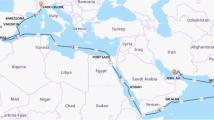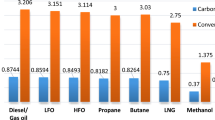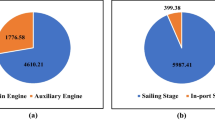Abstract
The international maritime organization (IMO) has introduced several legislations to optimize the use of energy generated from machinery onboard ships to reduce the emitted exhaust gas emissions. The aim of the current paper is to study the effect of using emission reduction strategies for container ships with emphasis on the improved Energy Efficiency Design Index (EEDI) from environmental and economic points of view. As a case study, A19 and A7 class container ships are investigated. Three different options are considered including natural gas, treatment equipment, and ship speed reduction. The lowest annual emission rates per transported cargo are achieved by A19. These rates are 18.9, 0.93, and 1.8 kg/TEU for NOx, SOx, and CO2 emissions, respectively. In order to improve the EEDI value for the A7, the ship speed should be reduced by 22.5%. This will comply with the three phases of IMO requirements by reducing CO2 emissions with cost-effectiveness of 52.54 $/ton CO2. On the other hand, using the installed dual-fuel engine infrastructure onboard A19 container ship will improve the energy efficiency by 10.13% with annual fuel saving of 23.73 million dollars.















Similar content being viewed by others
Abbreviations
- CO2 :
-
Carbon dioxide emissions
- DFE:
-
Dual-fuel engine
- DO:
-
Diesel oil
- EEDI:
-
Energy Efficiency Design Index
- EEOI:
-
Energy Efficiency Operational Indicator
- HC:
-
Hydrocarbon emissions
- HFO:
-
Heavy fuel oil
- IMO:
-
International Maritime Organization
- MCR:
-
Maximum continuous rating of the engine
- NG:
-
Natural gas
- NOx :
-
Nitrogen oxide emissions
- PM:
-
Particulate matter
- S:
-
Sulfur
- SCR:
-
Selective catalytic reduction
- SOx :
-
Sulfur oxide emissions
- SWS:
-
Seawater scrubber
- TEU:
-
Twenty-foot equivalent unit
- ULSFO:
-
Ultra-low sulfur fuel oil
References
ABS (2013) Ship energy efficiency measures: status and guidance. American Bureau of Shipping, Houston, pp 20–35
Alisafaki AG, Papanikolaou AD (2015) On the Energy Efficiency Design Index of Ro-Ro passenger and RO-RO cargo ships. Proc Insti Mech Eng Part M: Journal of Engineering for the Maritime Environment 231(1):19–30
Ammar NR (2018) Energy- and cost-efficiency analysis of greenhouse gas emission reduction using slow steaming of ships: case study RO-RO cargo vessel. Ships Offshore Struct 13(8):868–876
Ammar NR (2019a) Environmental and cost-effectiveness comparison of dual fuel propulsion options for emissions reduction onboard LNG carriers. Brodogradnja 70:61–77
Ammar NR (2019b) An environmental and economic analysis of methanol fuel for a cellular container ship. Transp Res Part D: Transp Environ 69:66–76
Ammar NR, Seddiek IS (2017) Eco-environmental analysis of ship emission control methods: case study RO-RO cargo vessel. Ocean Eng 137:166–173
Ammar NR, Seddiek IS (2018) Thermodynamic, environmental and economic analysis of absorption air conditioning unit for emissions reduction onboard passenger ships. Transp Res Part D: Transp Environ 62:726–738
Ančić I, Šestan A (2015) Influence of the required EEDI reduction factor on the CO2 emission from bulk carriers. Energy Policy 84(Supplement C):107–116
Banawan AA, El Gohary MM, Sadek IS (2010) Environmental and economical benefits of changing from marine diesel oil to natural-gas fuel for short-voyage high-power passenger ships. Proc Instit Mech Eng Part M-J Eng Marit Environ 224(M2):103–113
Banawan AA, Mosleh M, Seddiek IS (2013) Prediction of the fuel saving and emissions reduction by decreasing speed of a catamaran. J Marine Eng Technol 12(3):40–48
Benvenuto G, Trucco A, Campora U (2014) Optimization of waste heat recovery from the exhaust gas of marine diesel engines. Proc Instit Mech Eng Part M: Journal of Engineering for the Maritime Environment 230(1):83–94
Bishop JDK, Martin NPD, Boies AM (2014) Cost-effectiveness of alternative powertrains for reduced energy use and CO2 emissions in passenger vehicles. Appl Energy 124(Supplement C):44–61
Bøckmann E, Steen S (2016) Calculation of EEDIweather for a general cargo vessel. Ocean Eng 122(Supplement C):68–73
Brent-Petersen, H., Rex, C. 2018. Shipping market review 2018. DANISH SHIP FINANCE technical report. Available: https://www.shipfinance.dk/media/1817/shipping-market-review-may-2018.pdf (Accessed 9 May 2019)
Bunkerworld. 2019. Bunkerworld. Fuel prices. Available: http://www.bunkerworld.com/prices/ (Accessed 15 April 2019)
Chang C-C, Wang C-M (2014) Evaluating the effects of speed reduce for shipping costs and CO2 emission. Transp Res Part D: Transp Environ 31(Supplement C):110–115
Contini D, Gambaro A, Donateo A, Cescon P, Cesari D, Merico E, Belosi F, Citron M (2015) Inter-annual trend of the primary contribution of ship emissions to PM2.5 concentrations in Venice (Italy): efficiency of emissions mitigation strategies. Atmos Environ 102:183–190
Corbett JJ, Wang H, Winebrake JJ (2009) The effectiveness and costs of speed reductions on emissions from international shipping. Transp Res Part D: Transp Environ 14(8):593–598
Deloitte. 2019. New Zealand ports and freight year book. Technical report. Available: https://www2.deloitte.com/nz/en/pages/finance/articles/new-zealand-ports-and-freight-yearbook.html (Accessed 20 April 2019)
Diab F, Lan H, Ali S (2016) Novel comparison study between the hybrid renewable energy systems on land and on ship. Renew Sust Energ Rev 63:452–463
Doudnikoff M, Gouvernal E, Lacoste R (2014) The reduction of ship-based emissions: aggregated impact on costs and emissions for North Europe-East Asia liner services. Int J Shipp Transp Logist 6(2):213–233
Dragan, D., Kramberger, T., Intihar, M., 2014. A comparison of methods for forecasting the container throughput in north Adriatic ports
EEA, 2000. Analysis of commercial marine vessels e and fuel consumption data. Office of transportation and air quality, U.S. Environmental Protection Agency
EIA. 2019. Short-term energy outlook, U.S. Energy Information Administration. Available: https://www.eia.gov/todayinenergy/detail.php?id=34492 (Accessed 15 April 2019)
Eide MS, Endresen Ø, Skjong R, Longva T, Alvik S (2009) Cost-effectiveness assessment of CO2 reducing measures in shipping. Marit Policy Manag 36(4):367–384
El Gohary MM, Seddiek IS, Salem AM (2015) Overview of alternative fuels with emphasis on the potential of liquefied natural gas as future marine fuel. Proc Instit Mech Eng Part M: Journal of Engineering for the Maritime Environment 229(4):365–375
Faber, J., Huigen, T., Nelissen, D. 2017. Regulating speed: a short-term measure to reduce maritime GHG emissions. Available: http://www.cleanshipping.org/download/Slow-steaming-CE-Delft-final.pdf (Accessed 28 November 2017)
FleetMon. 2019. Al Dahna container ship. Available: https://www.fleetmon.com/vessels/al-hilal_9349552_57576/?language=en ()
GL. 2013. Guidelines for determination of the Energy Efficiency Design Index. Available: http://rules.dnvgl.com/docs/pdf/gl/maritimerules2016July/gl_vi-13-1_e.pdf (Accessed 3 December 2017)
Guangrong, Z., Kinnunen, A., Tervo, K., Elg, M., Tammi, K., Kovanen, P., 2013. Modeling ship energy flow with multi-domain simulation, 27th CIMAC World Congress on Combustion Engines. International Council on Combustion Engines, Paper NO.: 279, Shanghai, China
Hapag L. 2019a. Products, Al Dahna and Al Hilal container ships Available: https://www.hapag-lloyd.com/en/products.html (Accessed 15 June 2019)
Hapag L. 2019b. Services and trades. Hapag-Lloyd. Available: https://www.hapag-lloyd.com/en/service-finder/bydeparture.html (Accessed 20 July 2019)
Hunt E, Butman B (1995) Marine engineering economics and cost analysis. Cornell Maritime Press, Centreville (accessed)
ICF, (2009a). Current methodologies in preparing mobile source port-related emission inventories. U.S. Environmental Protection Agency, pp. 50–60
ICF, 2009b. Towboat emission reduction feasibility study, U.S. Environmental Protection Agency
IMO, (2009). Guidelines for voluntary use of the ship energy efficiency operational indicator (EEOI). MEPC.1/Circ.684, London
IMO (2014a) Third IMO GHG study 2014. Executive summary and final report, MEPC 67/6/INF.3. International Maritime Organization, London.
IMO (2014b) Resolution MEPC 245(66): 2014 guidelines on the method of calculation of the attained Energy Efficiency Design Index (EEDI) for new ships. MEPC 66/21/Add.1, Annex 5, 4 April 2014. International Maritime Organization, London.
INTERTANKO. 2007. Use of MDO by ships part of holistic approach. Bunker summit, Greece. Available: https://www.intertanko.com/ (Accessed 22 December 2018)
IRCLASS. (2013). Ship Energy Efficiency Management Plan (SEEMP), guidance notes for ship owners and ship operators. Indian register of shipping. Available: http://www.irclass.org/media/1397/ship-energy-efficiency-management-plan.pdf (Accessed 6 November 2019)
Jakub K, Damian S, Krystyna P (2016) The impact of particulate matter (PM) and nitric oxides (NOx) on human health and an analysis of selected sources accounting for their emission in Poland. Medycyna Rodowiskowa 19(3):7–15
Johansson L, Jalkanen J-P, Kukkonen J (2017) Global assessment of shipping emissions in 2015 on a high spatial and temporal resolution. Atmos Environ 167:403–415
Kim K-H, Kabir E, Kabir S (2015) A review on the human health impact of airborne particulate matter. Environ Int 74:136–143
Knowler, G. 2019. Global container growth forecast to rebound. Available: https://www.joc.com/maritime-news/global-container-growth-forecast-rebound_20190425.html (Accessed 28 December 2019)
Marine Traffic. 2019. Al Hilal container ship. Available: https://www.fleetmon.com/vessels/al-hilal_9349552_57576/?language=en (Accessed 16 June 2019)
Martin S, Martin J, Pettit S (2015) Container ship size and the implications on port call workload. Int J Shipp Transp Logist 7(5):553–569
MEPC (2016) Air pollution and energy efficiency : supplementary information on the draft revised guidelines for determining minimum propulsion power to maintain the manoeuvrability of ships in adverse conditions (MEPC 70/INF.30). Marine Environment Protection Committee, London
Mikelis NE (2008) A statistical overview of ship recycling. J Marit Affairs 7(1):227–239
Nikopoulou Z, 2008. Reduction of NOx and SOx in an emission market -a snapshot of prospects and benefits for ships in the northern European SECA area, Department of shipping and marine technology ,Division of propulsion and maritime environment, Chalmbers University of technology, ISSN 1652–9189, Report No. 08:107, Göteborg, Sweden
Pani C, Vanelslander T, Fancello G, Cannas M (2015) Prediction of late/early arrivals in container terminals - a qualitative approach. Eur J Transp Infrastruct Res 15:536–550
Papanikolaou A, Zaraphonitis G, Bitner-Gregersen E, Shigunov V, Moctar OE, Soares CG, Reddy DN, Sprenger F (2016) Energy efficient safe ship operation (SHOPERA). Transp Res Proc 14:820–829
Perera LP, Mo B (2016) Emission control based energy efficiency measures in ship operations. Appl Ocean Res 60(Supplement C):29–46
Rehmatulla N, Calleya J, Smith T (2017) The implementation of technical energy efficiency and CO2 emission reduction measures in shipping. Ocean Eng 139:184–197
Sarasquete, A., Juandó, A., Caldas, A., Zapata, F., 2011. Energy efficiency audits on ships: hydrodynamic aspects for energy efficiency improvements, International Congress of Design and Naval Engineering Cartagena de Indias, Colombia
Seddiek IS (2016) Two-step strategies towards fuel saving and emissions reduction onboard ships. Ships Offshore Struct 11(8):791–801
Seddiek IS, Elgohary MM (2014) Eco-friendly selection of ship emissions reduction strategies with emphasis on SOx and NOx emissions. Int J Naval Archit Ocean Eng 6(3):737–748
Stopford M (2009) Maritime economics, 3rd edn. Routledge, London
Tezdogan T, Incecik A, Turan O (2014) Operability assessment of high speed passenger ships based on human comfort criteria. Ocean Eng 89:32–52
Tezdogan T, Incecik A, Turan O, Kellett P (2016) Assessing the impact of a slow steaming approach on reducing the fuel consumption of a containership advancing in head seas. Transp Res Proc 14:1659–1668
Tran TA (2017) A research on the energy efficiency operational indicator EEOI calculation tool on M/V NSU JUSTICE of VINIC transportation company, Vietnam. J Ocean Eng Sci 2(1):55–60
UNCTAD. 2011. Review of maritime transport. United Nations Conference on Trade and Development. Available: https://unctad.org/SearchCenter/Pages/Results.aspx?k=Review%20of%20Maritime%20Transport (Accessed 9 May 2019)
UNCTAD. 2019. Review of maritime transport 2019. United Nations Conference on Trade and Development. Available: https://unctad.org/en/PublicationsLibrary/rmt2019_en.pdf (Accessed 28 December 2019)
Wang C, Corbett JJ (2007) The cost and benefits of reducing SO2 emissions from ships in the US west coastal waters. Transp Res D 12:577–588
Wartsila. 2008. WÄRTSILÄ RT-flex96C AND WÄRTSILÄ RTA96C technology review. WÄRTSILÄ. Available: http://www.test.swiss-ships.ch/berichte/berichte/waertsilae/Wartsila-RTA96C-engine-technology-review.pdf (Accessed 16 June 2019)
Wärtsilä. 2016. Scrubber system designs. Available: http://www.wartsila.com/products/marine-oil-gas/exhaust-gas-cleaning/sox-abatement/scrubber-system-designs (Accessed 2 October 2019)
Yang ZL, Zhang D, Caglayan O, Jenkinson ID, Bonsall S, Wang J, Huang M, Yan XP (2012) Selection of techniques for reducing shipping NOx and SOx emissions. Transp Res Part D: Transp Environ 17(6):478–486
Zhu Y, Zhou S, Feng Y, Hu Z, Yuan L (2017) Influences of solar energy on the energy efficiency design index for new building ships. Int J Hydrog Energy 42(30):19389–19394
Acknowledgments
The authors gratefully acknowledge the DSR for technical and financial support.
Funding
This work was funded by the Deanship of Scientific Research (DSR), King Abdulaziz University, Jeddah, under grant no. D-094-980-1440.
Author information
Authors and Affiliations
Corresponding author
Additional information
Responsible editor: Philippe Garrigues
Publisher’s note
Springer Nature remains neutral with regard to jurisdictional claims in published maps and institutional affiliations.
Rights and permissions
About this article
Cite this article
Ammar, N.R., Seddiek, I.S. An environmental and economic analysis of emission reduction strategies for container ships with emphasis on the improved energy efficiency indexes. Environ Sci Pollut Res 27, 23342–23355 (2020). https://doi.org/10.1007/s11356-020-08861-7
Received:
Accepted:
Published:
Issue Date:
DOI: https://doi.org/10.1007/s11356-020-08861-7




